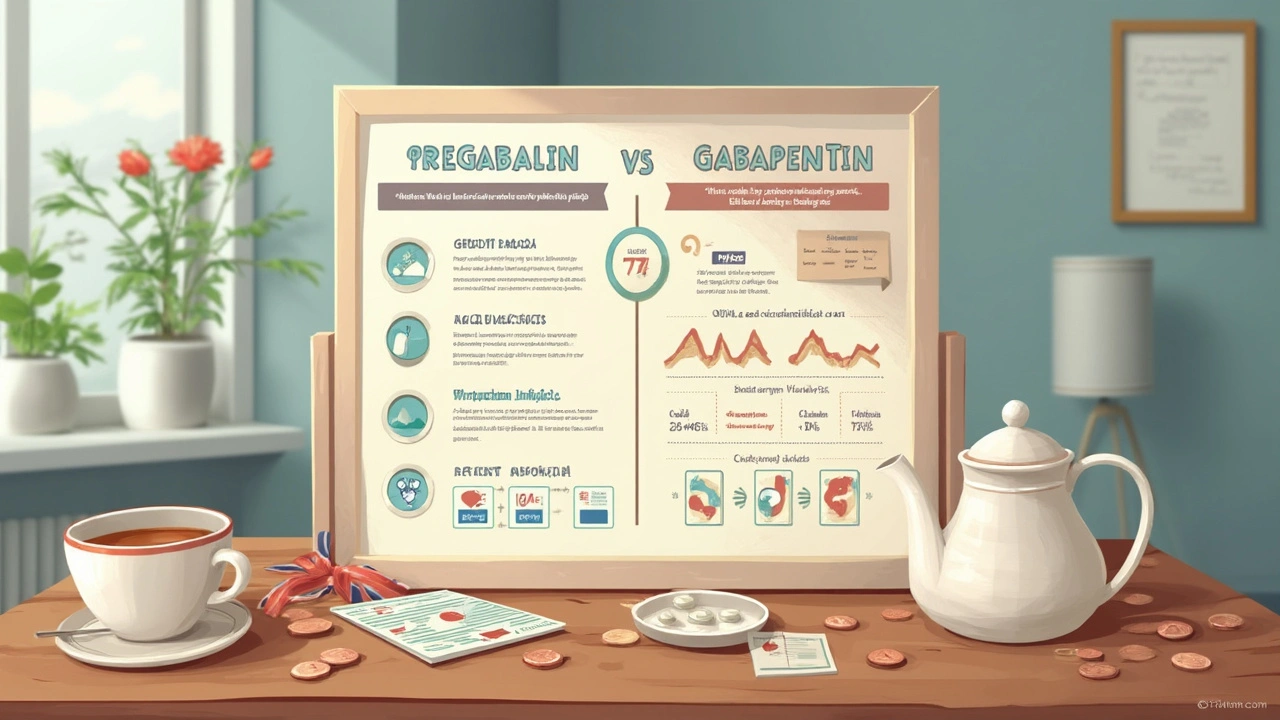How Pregabalin and Gabapentin Work: Similarities and Subtle Differences
When it comes to managing chronic pain or nerve conditions, two medicines often come up: pregabalin and gabapentin. Both of these belong to a family of drugs called gabapentinoids. They’re often prescribed for nerve pain, fibromyalgia, anxiety, and some types of seizures. They work by affecting how nerves send signals to the brain. In technical terms, both block certain calcium channels in the nervous system, which helps calm overactive nerves. But if you peek behind the pharmacy counter, there are small but important distinctions.
Pregabalin, known by its brand name Lyrica, is actually a newer version of gabapentin (Neurontin). One big difference? The body absorbs pregabalin more reliably. With gabapentin, the higher the dose you take, the less your body absorbs, which can be frustrating if you’re trying to get your symptoms under control. Pregabalin, however, gets into your blood at about the same rate, no matter the dose. That’s why doctors can usually predict its effects better.
But absorption tells only half the story. Gabapentin has been around for decades, approved since the early 1990s, while pregabalin hit the scene in 2004. Despite their similarities, clinical trials have shown some nuanced differences in how each tackles pain. For nerve pain after shingles (postherpetic neuralgia), fibromyalgia, and diabetic neuropathy, both drugs are effective, but some head-to-head comparisons suggest pregabalin can kick in faster—sometimes within one week. Gabapentin might take up to a couple of weeks for relief to show up.
When it comes to anxiety, especially generalized anxiety disorder, pregabalin seems to have the upper hand. In Europe, it’s even approved for this indication, although in the U.S. and many places, it's an off-label use for both drugs. Interestingly, both can help people with restless leg syndrome and certain seizure disorders, but gabapentin is also a go-to for hot flashes in menopausal women and as a support for alcohol withdrawal.
The question is, are these subtle differences meaningful for everyday people? For someone with regular nerve pain, either one can do the job. But if you have trouble absorbing meds or your pain is resistant to the starter doses, pregabalin’s predictable absorption and stronger punch might win out. If you want more options for extended-release forms (think: less frequent dosing), gabapentin ER is available too, offering some flexibility if remembering doses is a concern.
Digging into costs and insurance approvals, these details do color treatment choices. Pregabalin was protected by patents for a long time and tended to be pricier, but since generics became available, prices have dropped. Gabapentin is widely available as a generic and almost always covered by insurance. If your insurer rejects pregabalin, don’t panic—gabapentin remains a tried-and-true backup. For people in countries without robust healthcare, cost differences can actually make the decision for them.
Wondering about more substitutes for gabapentin? You can check out a handy guide on the best gabapentin substitute options that have made waves in 2025. With all these choices, making an informed decision can be easier than you think.
So, both pregabalin and gabapentin belong to the same family tree but come with their own quirks. If you ever find that your medication isn’t doing the trick—or causes too many problems—talk to your doctor to see if switching makes sense. Whether it's rapid action for anxiety or a slow build for chronic pain, knowing the subtle differences means you’ll be better prepared to advocate for your own care.

Comparing Efficacy and Patient Experiences
A big question that hangs over the heads of anyone starting these meds: Will they actually work for me? Clinical studies have given us some useful clues. Across multiple trials, both gabapentin and pregabalin have shown solid results in easing nerve pain. The gold-standard studies in diabetic neuropathy, spinal cord injuries, and fibromyalgia typically report that about 30-50% of folks experience meaningful relief with either drug. That’s not a magic bullet, but for anyone who’s struggled with nerve zaps, burning, or electric shock sensations, it’s a lifeline.
Pregabalin, due to its more predictable absorption, sometimes edges out gabapentin for speed at which people start feeling better. For instance, a high-profile 2018 trial found that patients with postherpetic neuralgia started to see pain reduction up to a week sooner on pregabalin compared to gabapentin. Fast relief can matter a lot when you’re stuck with daily pain or insomnia from nerve issues.
For fibromyalgia, both drugs have FDA approval in the U.S., but patient forums and support groups often share that some people find pregabalin takes the edge off pain and sleep problems faster. With gabapentin, the onset is slower and you sometimes need to play with the dosing for a couple of weeks before the sweet spot reveals itself. A tip here if you’re newly prescribed gabapentin: stick to the dosing schedule, even if the relief takes awhile. Giving up too soon is a common reason for gaps in pain control.
When it comes to anxiety, especially the lingering, gnawing type tied to generalized anxiety disorder, pregabalin appears to be more consistently effective. European trials support this, and off-label, many U.S. psychiatrists prescribe pregabalin for tough cases, especially for people sensitive to the groggy side effects of traditional anti-anxiety meds. So if nerve pain and anxiety travel hand-in-hand for you—pregabalin might hit two birds with one prescription.
But it's not all about pain and anxiety. Gabapentin has found its way into some pretty unique niches. Did you know it’s sometimes prescribed for chronic cough? Even dogs and cats have benefitted—for pain, post-surgical discomfort, and anxiety in vet clinics! Pregabalin, meanwhile, gets occasional use for hot flashes and even alcohol withdrawal, but less often than gabapentin.
Not all stories end on a high note. Some people don’t feel any change—or find the side effects too much. In Facebook groups, you’ll spot posts from people who found gabapentin caused more drowsiness, while others on pregabalin ended up battling swelling (edema) or blurred vision. Bodies react differently, which is why doctors often start with smaller doses and ramp up slowly.
Let’s peek at a side-by-side numbers snapshot to highlight the real-life impact of these two medications:
| Aspect | Gabapentin | Pregabalin |
|---|---|---|
| Onset of Action | 1-2 weeks | Few days – 1 week |
| Pain Reduction (severe cases) | ~40% | ~46% |
| FDA Approval for Anxiety | No | Not in US (but widespread off-label use globally) |
| Patient Reported Drowsiness | 25-30% | 15-25% |
Of course, numbers only tell part of the story. Many people switch from one to the other after reporting side effects, insurance denials, or just not feeling "right." There’s no harm in working with your healthcare provider to figure out the most effective pain management strategy for you—even if it means trying both. Dosing flexibility, speed of effect, and insurance coverage all play a role in how satisfied people are. Don’t be shy to advocate for a switch if you’re stuck in a rut with your current plan.

Side Effects, Cost, and Practical Tips for Choosing
No drug is without downsides, and gabapentinoids are no exception. Drowsiness and dizziness rank near the top for both drugs—especially in the first few weeks or when increasing the dose. People sometimes describe the sensation as "walking through fog." If you have to drive or handle machinery at work, this can be more than a minor nuisance. Pregabalin tends to cause less drowsiness as the dose goes up, though some people notice leg swelling and occasional weight gain.
Gabapentin brings its own baggage. Some people notice problems with swelling, blurred vision, or tremors, but drowsiness seems to hit a little harder than with pregabalin. Side effects can sneak up if doses are ramped up quickly, so slow and steady usually keeps you out of trouble. Interestingly, the risk of "tolerance"—where the effect wanes as the body gets used to the drug—appears about the same, though there’s debate in the chronic pain community about whether this is real or more a factor of disease progression.
Withdrawal from either drug is a concern if you stop cold turkey, especially after high doses or long-term use. Symptoms like insomnia, agitation, sweating, and sometimes even seizures can happen. Taper slowly with your doctor’s help to cut this risk way down. Never just toss your pills or decide you’re "done"—that can backfire.
Let’s talk money. Once upon a time, pregabalin’s price tag induced sticker shock (it cost nearly $600 for a month’s supply in the U.S. before generics!), while gabapentin was dirt cheap. Fast forward to 2025: Pregabalin’s generic versions have taken a chainsaw to the price, but gabapentin still usually wins the budget battle at big-box pharmacies. A bottle of generic gabapentin can be less than $5 with insurance, while pregabalin hovers in the $10-30 range for many folks now that patents have expired.
Insurance quirks can muddy the waters. Some plans want you to try gabapentin first before they’ll pay for pregabalin—this is called "step therapy." Appeals are possible if pregabalin is medically justified, but you’ll need to coordinate with your provider and maybe jump through some hoops. If you’re uninsured, drug discount programs or pharmacy coupons can dramatically cut costs for either drug; don’t be afraid to comparison shop.
Here's a tip you won’t get everywhere: If side effects like drowsiness bug you, ask your doctor about taking most or all your dose before bedtime. Many people find this helps with sleep and minimizes daytime grogginess. Also, be upfront about any history of substance use. While gabapentinoids aren’t classically addictive, some folks have misused them, particularly those with a previous opioid use disorder. If you fit this category, let your doc know so they can keep tabs on your progress and adjust as needed.
Adherence makes or breaks success. Missing doses is one of the top reasons for "treatment failure." Set phone alarms or use pill organizers to keep on track. If extended-release options suit your schedule better—especially gabapentin ER—talk about that at your next appointment.
Finally, let’s clear up a common myth: Both drugs can be used together in rare cases, but it’s not common or widely recommended. This is usually only done under strict specialist supervision, for people with extreme or poorly controlled symptoms. For most, swapping one for the other (with a proper crossover period) is safer and less confusing.
If you’re searching for alternatives beyond these two, don’t hesitate to look at evidence-based guides featuring both mainstream and lesser-known neuromodulators. The world of gabapentin substitutes has exploded, providing options for people who don’t respond or tolerate the older standbys. Knowledge, patience, and a little trial-and-error usually pave the way to better days—and better nights.




Christopher MORRISSEY
This comparative analysis between pregabalin and gabapentin is rather enlightening. It is crucial to note the pharmacokinetic distinctions that contribute significantly to their efficacy. Pregabalin, being a more potent analogue, offers constancy in plasma concentration, which may explain its more rapid onset of action compared to gabapentin.
Furthermore, the side effect profiles do appear to diverge subtly yet importantly; patients often report differing tolerance levels between the two. The cost factor also cannot be ignored, particularly in health systems where prescription drug prices impact accessibility profoundly.
One must also consider individual patient histories and comorbidities before making any conclusive determination. Has anyone here experienced tolerability issues or cost burdens that have influenced your or a relative’s treatment choice?
christian quituisaca
Wow, this breakdown really hits home. I’ve seen a lot of folks struggle between picking pregabalin or gabapentin. The real-world insights on costs are often left out of professional articles, so it’s refreshing to see that included here.
The way they’ve pieced together patient experiences with hard stats is crucial for us who aren’t medical pros but want to make informed decisions. It’d be great if the article also touched on some natural alternatives or adjunct therapies to these meds.
In any case, this guide makes conversations with doctors more grounded and productive. Anyone else had a doctor reluctant to switch between the two despite side effects?
Patrick Nguyen
From a strictly grammatical standpoint, the article maintains a commendable level of clarity and polish, which enhances comprehension for a broad audience. However, I do wonder whether the term "efficacy" might have benefitted from further specification in terms of patient subgroups or pain types.
The juxtaposition of side effects and costs is well rendered, yet the economic data could be supplemented by regional pricing details, considering how significantly that can vary.
Still, it’s a useful primer for those pondering between gabapentin substitutes, especially with the detailed patient anecdotes interspersed throughout.
Greg DiMedio
Sure, pregabalin might be 'more potent', sure. But as if more power means better in all cases? Please. I bet it just equals more unwanted side effects and higher costs, right? The article’s tone is way too sanitized if you ask me.
I mean, gabapentin has been around forever and we know what to expect. Pregabalin? Pharma pushing another shiny new thing with no real added benefits for most users. Like we all have endless money to throw on prescriptions.
If you want my two cents, both medicines are just overhyped solutions anyway. But hey, that’s just me being lazy and skeptical ¯\_(ツ)_/¯.
Donnella Creppel
Eh, you guys are all missing the theatre of it all. It's not just about which chemical wins in some sterile lab test or a boring cost chart. The drama of side effects and personal journeys? Classic.
And don't even get me started on those pharmaceutical marketing ploys hidden behind careful stats. It's like buying a ticket to a tragicomic spectacle where your nerves are the lead character suffering in silence.
Someone spill the tea on any heartbreak stories? Which med crashed your vibe the worst? 'Cause you know, the *real* story is always juicier than some neat efficacy curve.
Adam O'Rourke
Oh gee, another article telling us how to pick between two meds with a side of patient stories. Riveting. ¯\_(ツ)_/¯
Honestly, who even pays attention to 'side effects' anymore? Pain's pain, right? And costs? Pfft. I’m sure we're all rolling in cash or just love to gamble with our health insurance.
Let’s see some real-world explosions or funny tales from someone who got totally switched up meds-wise, huh? Spoiler: placebo probably wins either way.
Javier Garcia
I’m intrigued by the comparative stats but curious about specific efficacy measures. For example, how do both meds perform across different types of neuropathic pain or anxiety disorders?
Also, does the article mention any long-term dependency concerns or withdrawal profiles? That information would be hugely beneficial when discussing alternatives with clinicians.
And for those with personal experience, how do you personally gauge improvement vs side effects?
Jarod Wooden
It is paramount—nay, imperative—that one scrutinize these pharmaceutics with a kaleidoscopic lens incorporating neurochemical, economic, and psychosocial vectors. Pregabalin's pharmacodynamic superiority is juxtaposed against a potentially onerous side effect latency, which may exacerbate neuroadaptive downregulation.
The cost matrix further convolutes patient compliance metrics, rendering simplistic efficacy comparisons almost myopic. We must transcend reductionist narratives to fully appreciate the entangled web of therapeutic outcomes.
The question remains: are we evaluating raw pharmacologic potency or the phenomenology of patient-experienced relief?
lee charlie
This article is quite a supportive resource, especially for folks like me who want to understand the basics before diving deeper with a healthcare provider.
Considering the balance between effectiveness and side effects is key, and it feels like the author took a thoughtful approach in laying out the pros and cons.
Does anyone have personal stories about switching from gabapentin to pregabalin or vice versa? How did that switch impact your quality of life or symptom management?
It’s always helpful to hear those firsthand perspectives alongside the clinical facts.
Badal Patel
Ah, the ceaseless conflict between tradition and modernity in pharmaceutical therapeutics! The article splendidly underscores this stark dichotomy.
Nevertheless, I must express a dramatic objection to the oversimplification in juxtaposing cost and effect without a nuanced exploration of pharmacoeconomic imperatives specific to socio-economic strata.
Could this not be construed as an affront to patients burdened by exorbitant drug pricing who nevertheless seek efficacious palliation for their neuropathic plight?
I urge an extension of this discourse to encompass ethical prescribing practices and healthcare accessibility.
KIRAN nadarla
The article nails a critical issue but skims over some essential details that can transform anecdotal evidence into robust conclusions.
Dependency profiles, tolerance development, and the role of genetic polymorphisms in patient response are glaring omissions.
Moreover, are pricing analyses adjusted for generic availability or insurance coverage variances? If not, the cost comparison is flawed and may mislead.
A comprehensive meta-analysis including these elements would serve prescribers and patients alike far better.
christian quituisaca
Spot on points about the gaps in the article. It’d be amazing if future updates could include more about genetic factors and insurance impacts on medication choices.
Also, I think a community thread sharing personal switch-over stories could be a fantastic companion piece. The human element often gets lost in clinical data, and real perspectives can illuminate the shades of grey.
Does anyone here feel comfortable sharing how their choice between these meds has played out long term?